There is no better place to see how land is formed and an active volcano in action than Volcanoes National Park in the island of Hawaii or the Big Island. This park has two of the world’s most active volcanoes – Kilauea and Mauna Loa. Here are some tips and things to do in Hawaii Volcanoes National Park with kids (and without too).
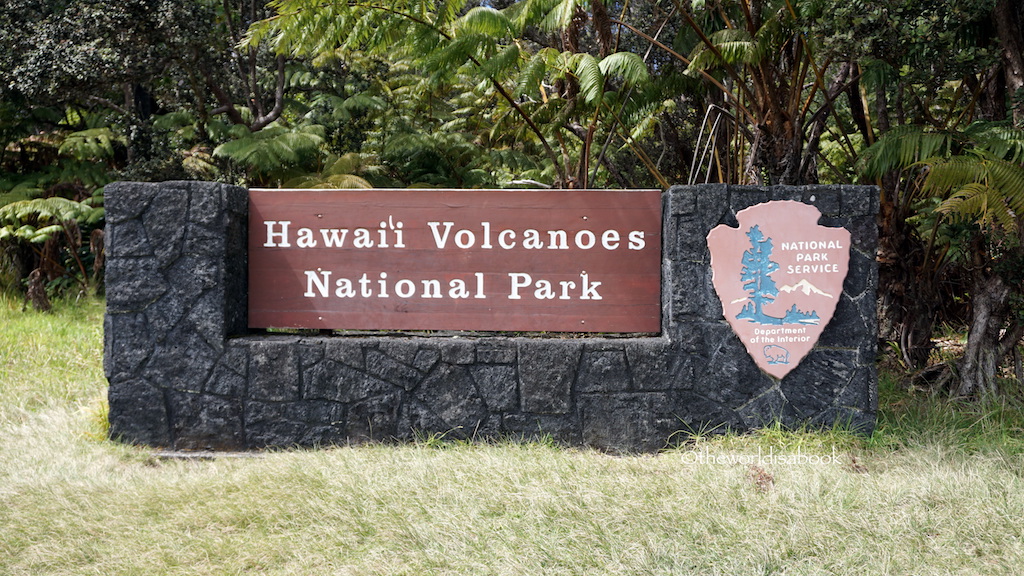
Land Creation
We have visited the island a few times and of course, can never resist going to this unique national park. Kīlauea and Mauna Loa changed the landscape of Hawaii.
These volcanoes created the Hawaiian island chain and continue to add land to this particular island. According to their site, this park “displays the results of at least 70 million years of volcanism, migration, and evolution”.
The National Park Service created this park to protect the natural areas around the volcanoes and protect the diverse flora and fauna found here as well as archaeological sites from ancient Hawaiians who used to live in the area.
Start at the Visitors Center
Like many national parks, every visit should always begin at the Visitor Center since they’re a wealth of information. There very comfortable auditorium has a movie shown on the hour from 9AM to 4 PM. Several rangers are on hand to answer any questions and help you plan itineraries depending on how many hours you have at the park.
Go on the Crater Rim Drive and Trail
There are two main roads through the park that give visitors a wonderful overview of everything this park has to offer. Crater Rim Drive is right off the Kilauea Visitor Center and covers four miles. Visitors should do this drive if your time is limited at the park.
Along the way, there are attractions like sulphur banks and steam vents. This was one of the steam vents. You can probably tell from my kids’ reactions, this had a pretty foul odor of burnt and bad egg smell.
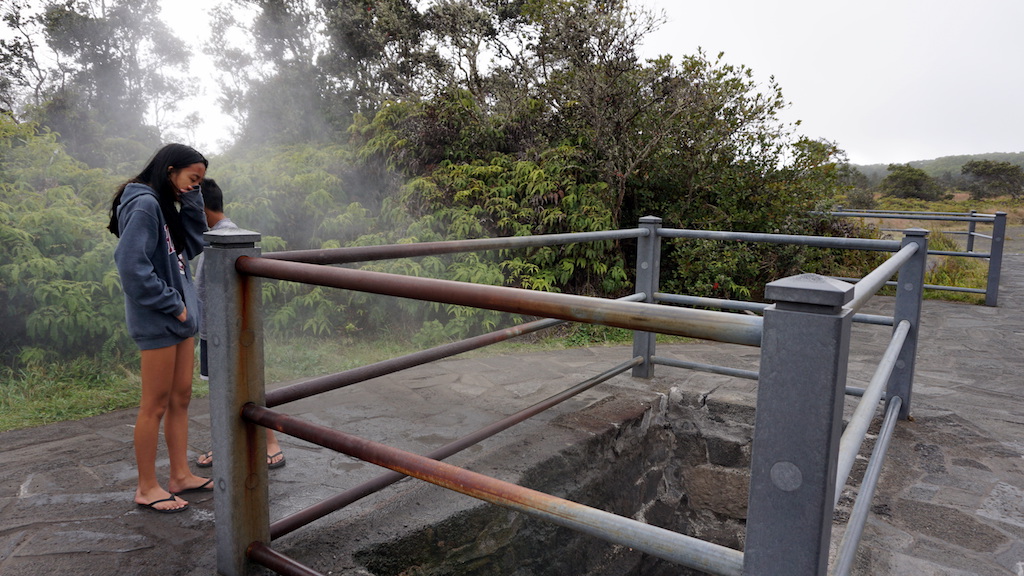
Go on the Crater Rim Trail
Don’t miss the Crater Rim Trail which gives visitors some great views of the Kilauea summit caldera. There are various point entries of this hike like the Kīlauea Overlook, Steam Vents, and Volcano House.
The trail covers the area of the 2018 summit collapse, steam vents and even part of a rainforest. The views of the caldera smoking and the lava beds are incredible.
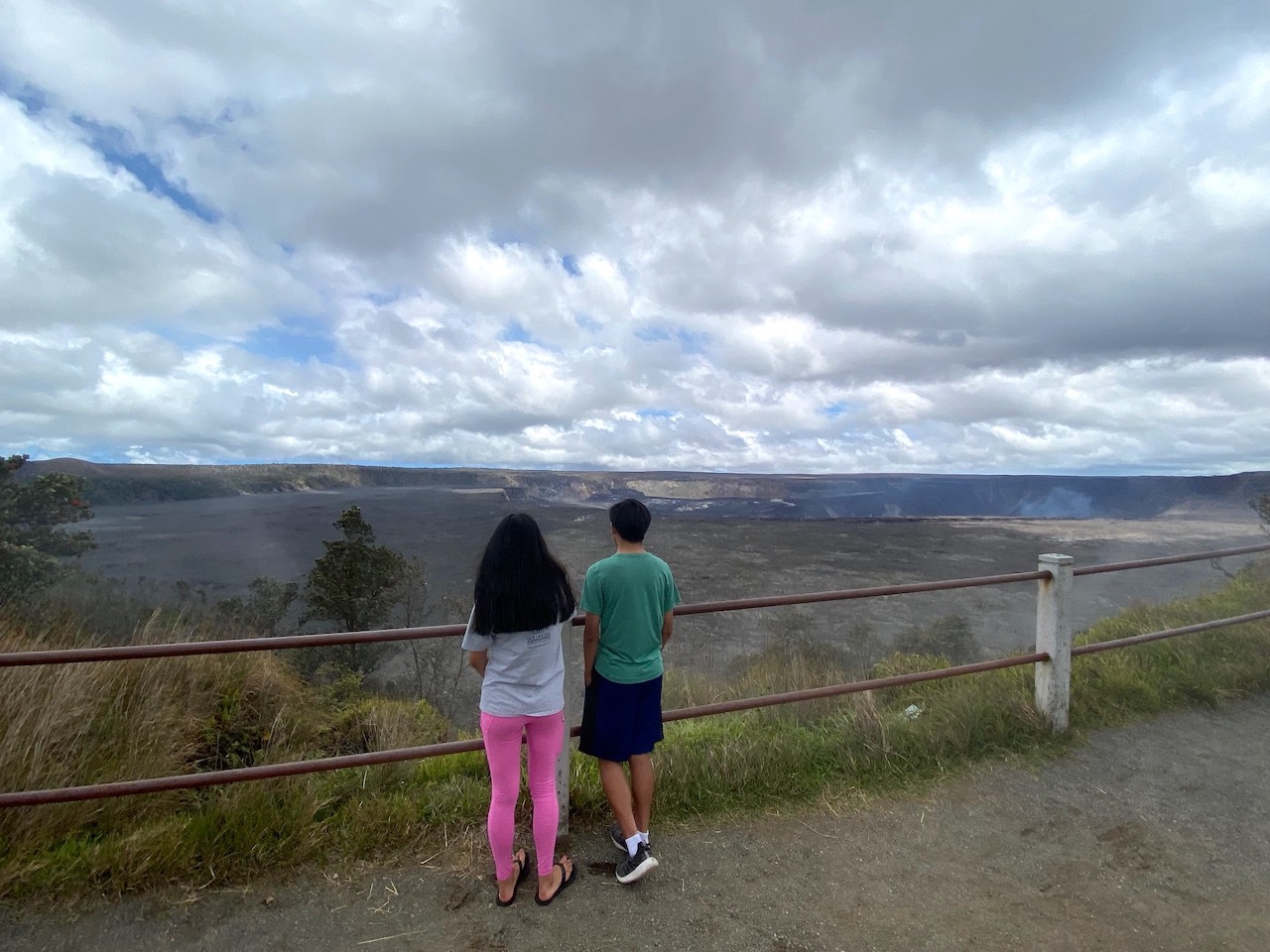
Most visitors flock to the overlook of the Kilauea caldera and main crater of Halema’uma’u at the end of this drive. It’s an amazing opportunity to see what scientists have called a “natural laboratory” that helps them better understand volcanoes. The Kilauea caldera has dramatically changed over the last 600 years.
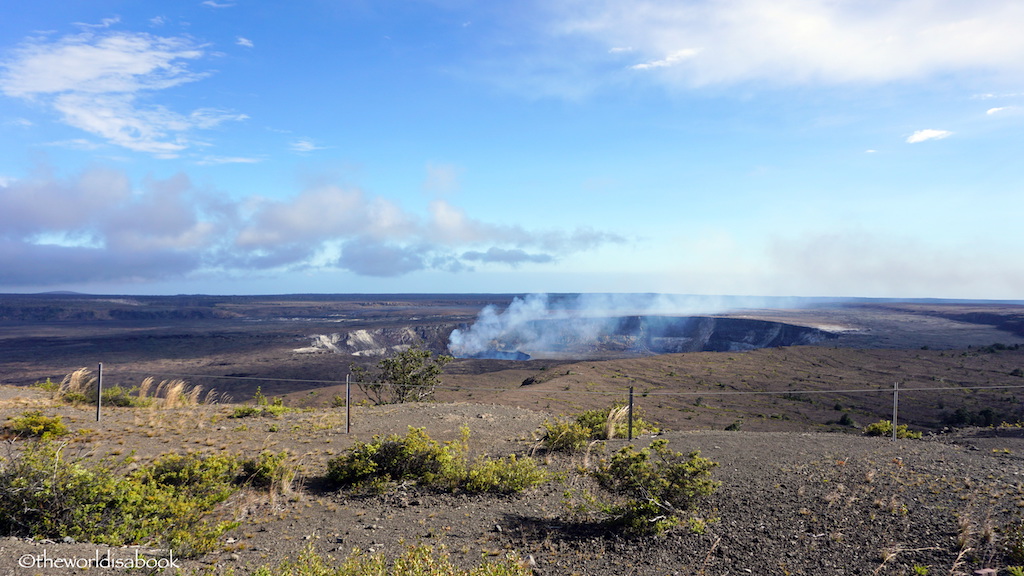
We could see smoke from the volcanic gas coming out of the caldera. The caldera spans over two miles with a lava lake below filled with molten magma.
The park rangers told us that you can see the lava lake glowing during dawn or dusk. Unfortunately, we’ve never stayed later to witness this glow.
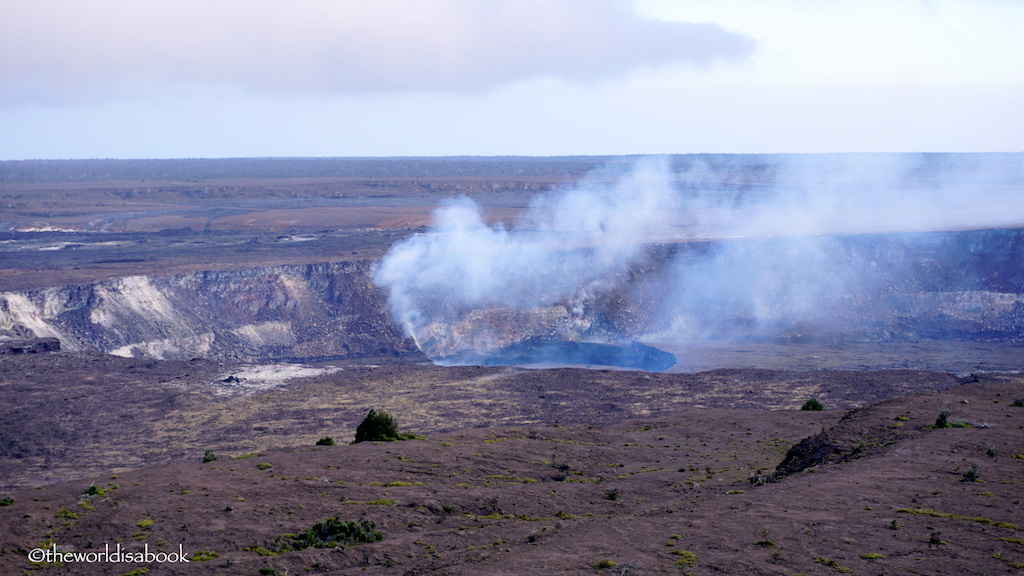
Another thing that makes this park unique is its connection with Hawaiian legends and culture. The Halema’uma’u Crater, within the Kilauea’s summit crater, is home of Pele, who is the Hawaiian volcano goddess. Some visitors throw their greeting leis into the caldera to honor Pele.
Go Inside the Thurston Lava Tube
On the other end of the Crater Rim Drive is Thurston Lava Tube or Nahuku. This is one of the park’s most visited attractions. It formed about 600 years ago but was discovered in 1913. Walking through the lava tube is a major highlight.
Lava tubes were created when lava from Kilauea flowed through here and air temperature cooled the surface to stone crust. However, the molten lava continued to to flow underneath the crust.
This river of lava kept draining underneath the crust and formed this cave looking attraction. We visited another one recently in Santa Cruz Island in the Galapagos.
Getting to the lava tube requires a 1/3 mile hike through a tree fern forest but on a paved walkway. We spotted some birds here so take a slow stroll into the lava tube and look up once in awhile. Some of those tree ferns were tall and plant types we didn’t really expect to see here.
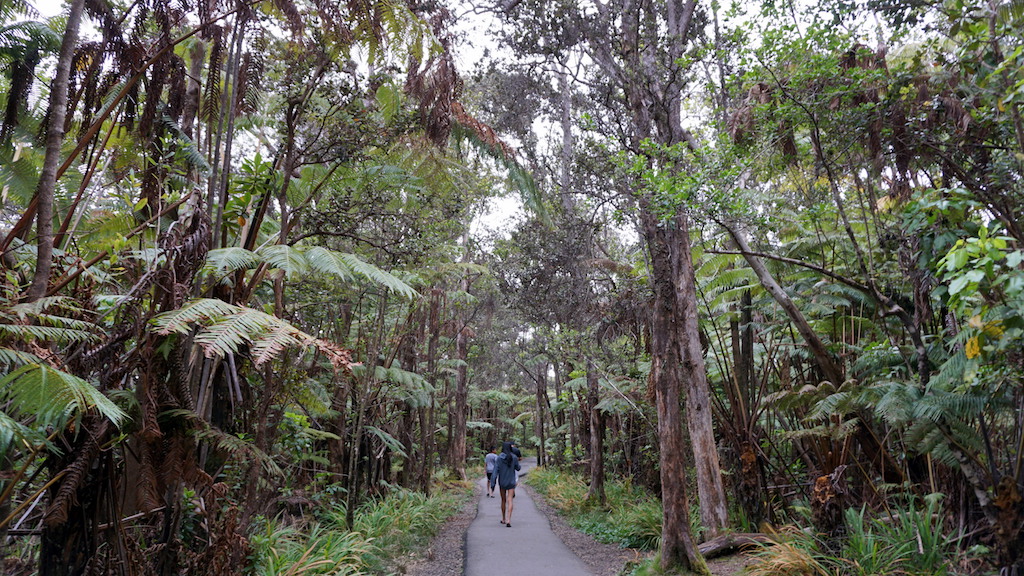
We were lucky enough to be inside the lava tube by ourselves. The pathway was well lit and it didn’t take very long to get across. It was surprising to see moss growing on the ceiling.
The walls had shelves called “bathtub rings” formed from the water. Despite its cold and dark environment, ancient Hawaiians used these lava tubes for shelter, getting water and storing food.
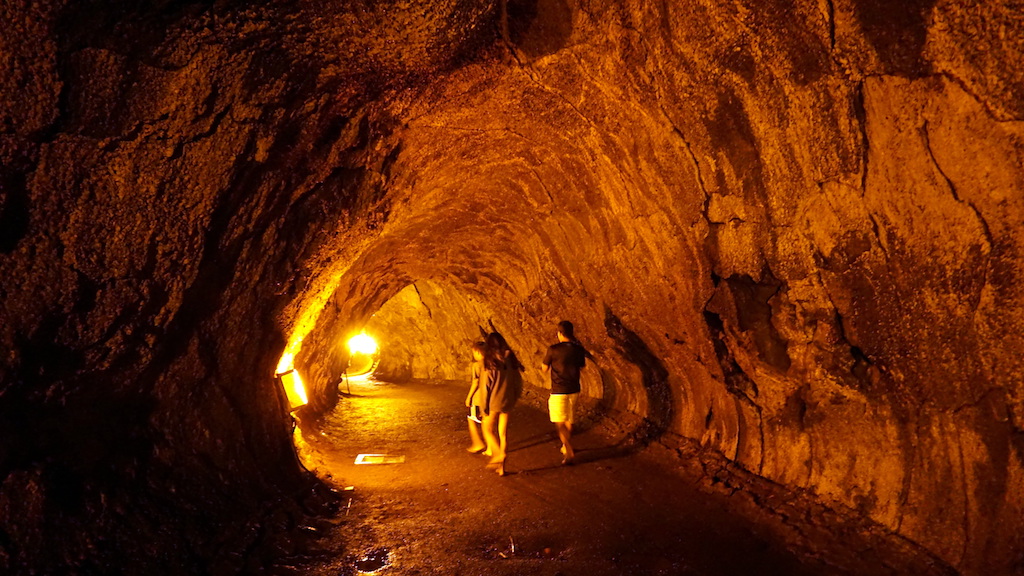
Drive the Chain of Craters Road
The other popular route is the 38-mile (61 km) round-trip drive along the Chain of Craters Road. This drive covers various landscapes from rainforest to dried lava as it descends 3,700 feet (1,128 m) to the coast.
The drive started out through lush forests. It was a bit surprising to see all of the verdant flora here.
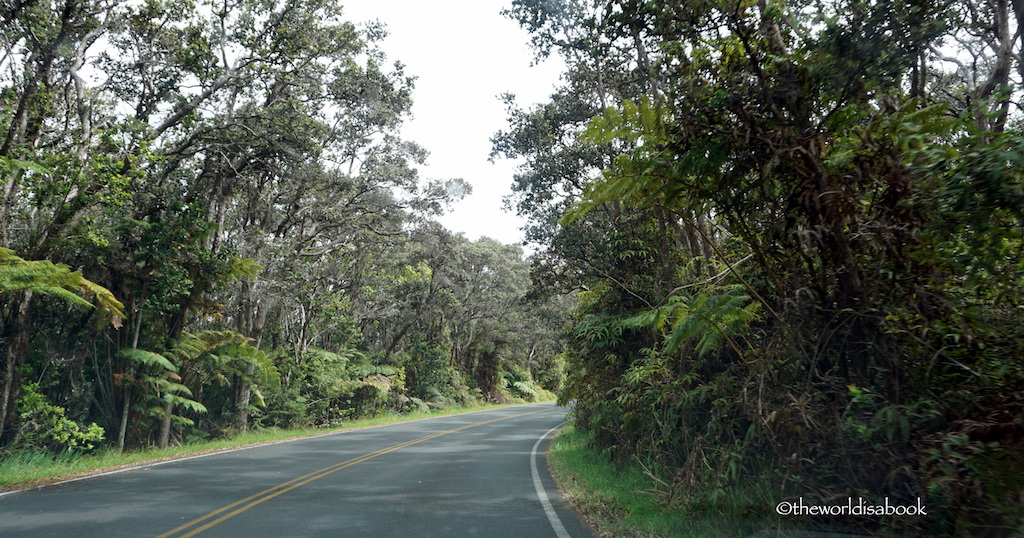
There is more to this park’s volcanic landscape that almost resembles an otherworldly island. There is a thriving ecosystem of diverse and native plants and animals within the park. Some are endemic to the islands. We loved seeing the ohi’a trees with their red “puff ball” flowers during our drive
There are various signs around the park to slow down so as not to run over the endangered Hawaiian goose or Nene. The Nene can only be found on the Hawaiian Islands and is the official state bird.
They are smaller than Canadian geese, who they shared ancestors, but also have less webbing on their feet so they can walk across lava rocks. We didn’t see any at the park but did see a few of them just a few hours earlier at the Mauna Kea area.
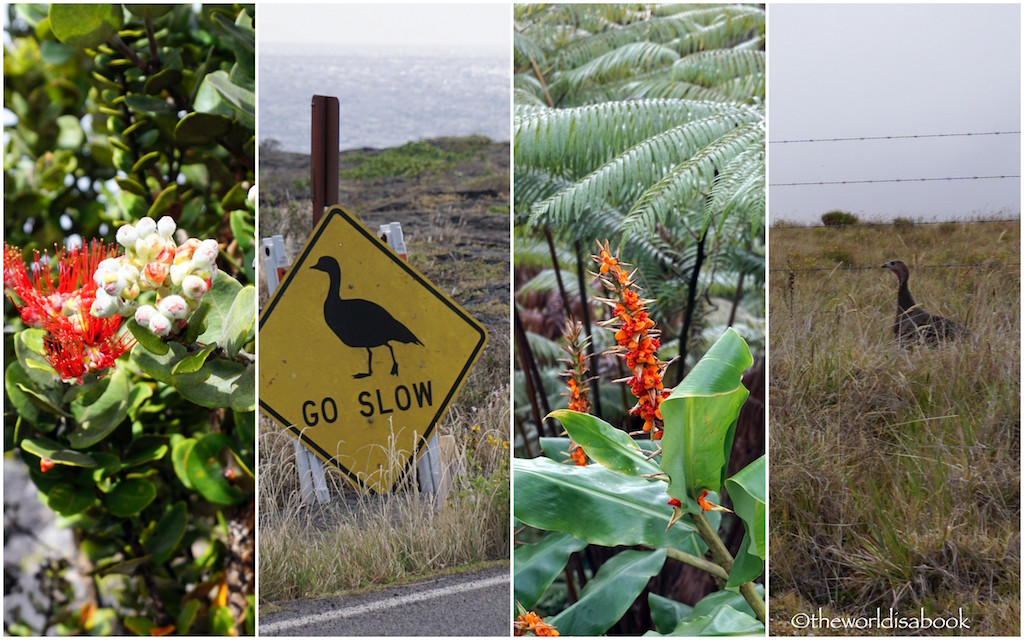
The drive eventually takes visitors through several lava fields and pit craters. Some are clearly marked so visitors can stop and see them further.
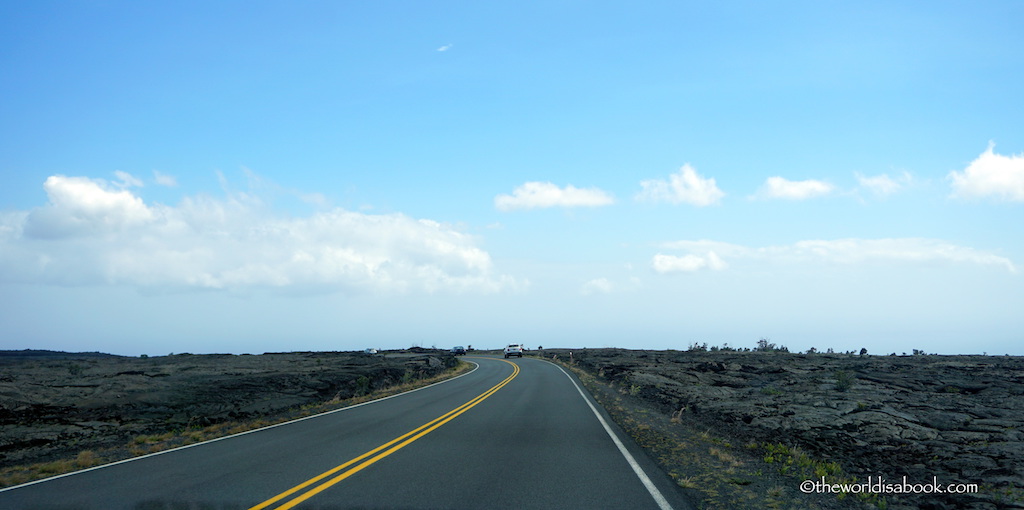
Stop at Kealakomo Overlook
The Kealakomo Overlook is one of the must stop places along this road. The lookout offers beautiful panoramic ocean views and the lava field that flowed through this area.
Unfortunately, this lava flow also covered the ancient village of Kealakomo which meant “the entrance path”. It also gave us an idea of how our distance to the end of the road.
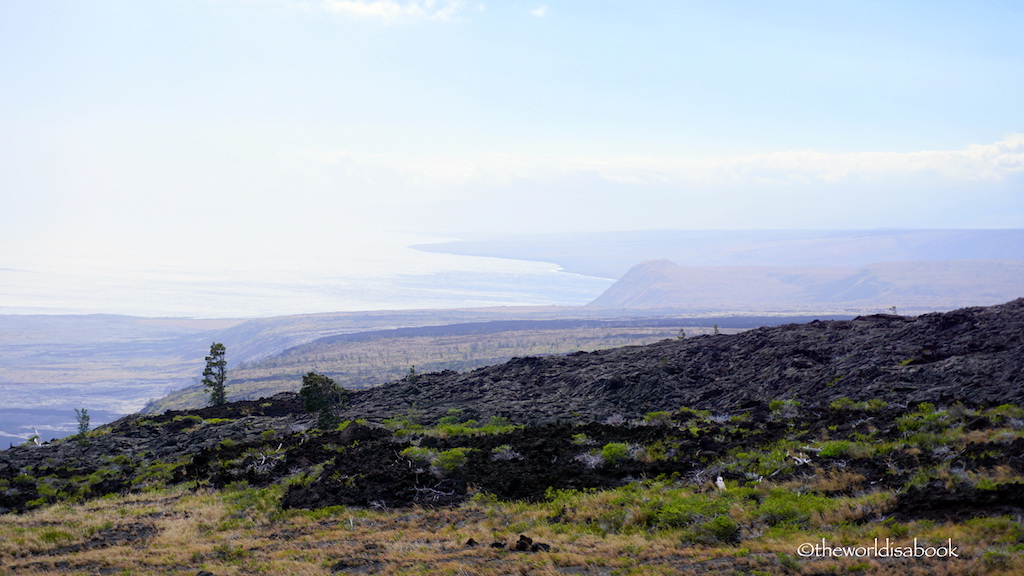
It was a winding drive down to the ocean. We stopped at the lava fields as we neared the ocean. It is an almost surreal landscape.
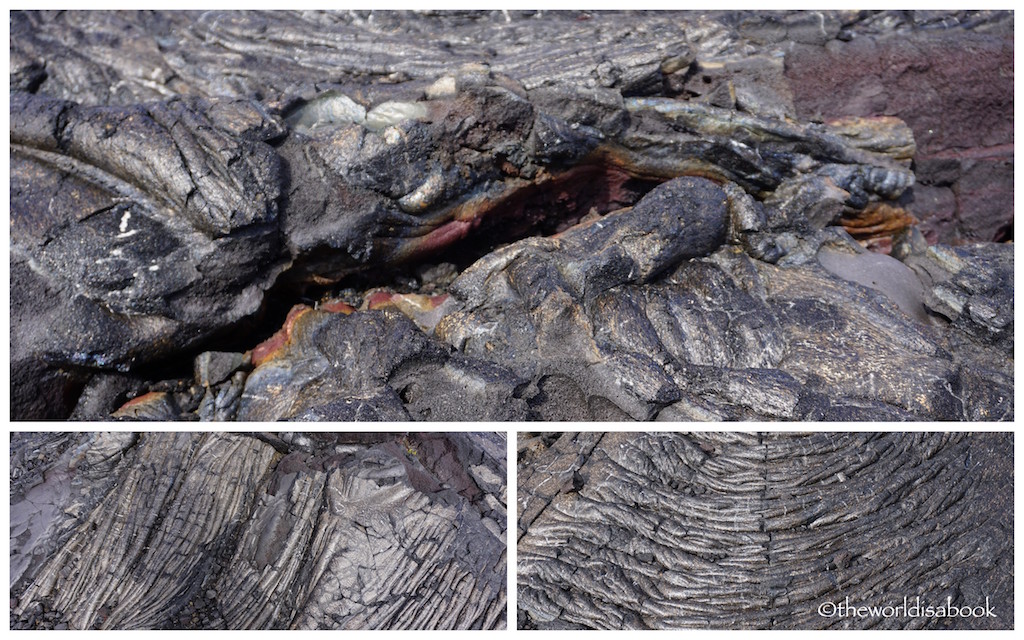
According to my kids, some areas looked like brownies that just came out of the oven. It really was a fascinating landscape.
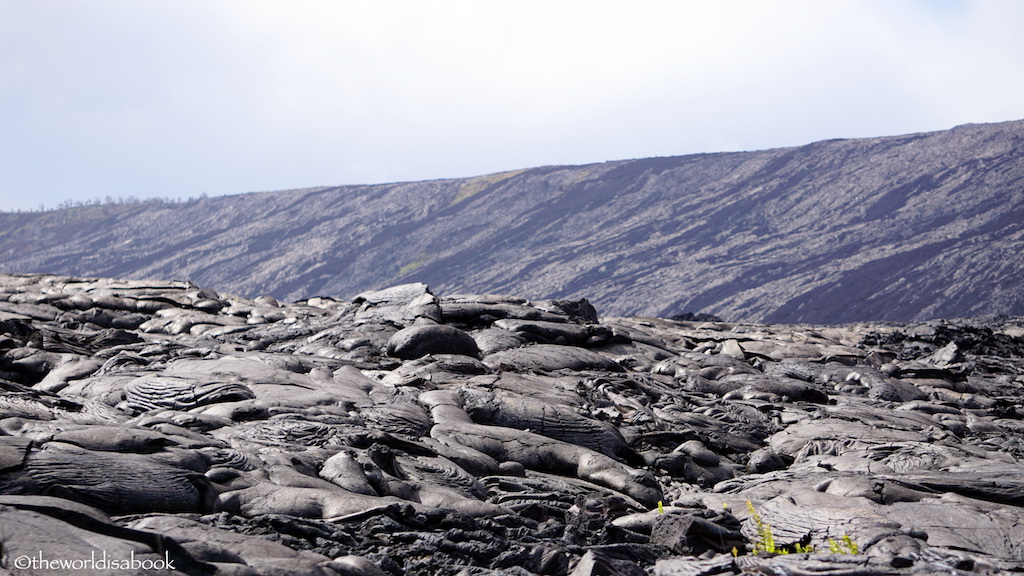
This is a beautiful drive to the coast. Several villages used to exist along this area with evidence of some agricultural sites and places like Pu’u Loa Petroglyphs where visitors can still see some of them. We saw this green patch on the cliff where we came from showing that life can emerge after the lava flow.
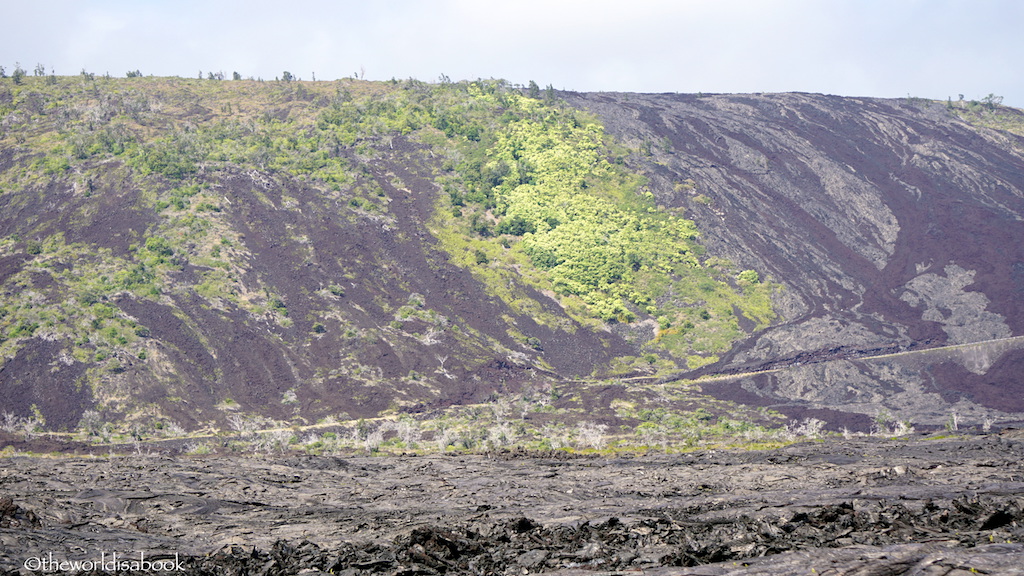
Chain of Craters Road coastline
The Chain of Craters Road ends at the coastline for some spectacular rock formations at the bottom of the cliff. We could see the path of the old lava that flowed into the ocean. One never really associates this park with these dramatic rock formations but they were amazing.
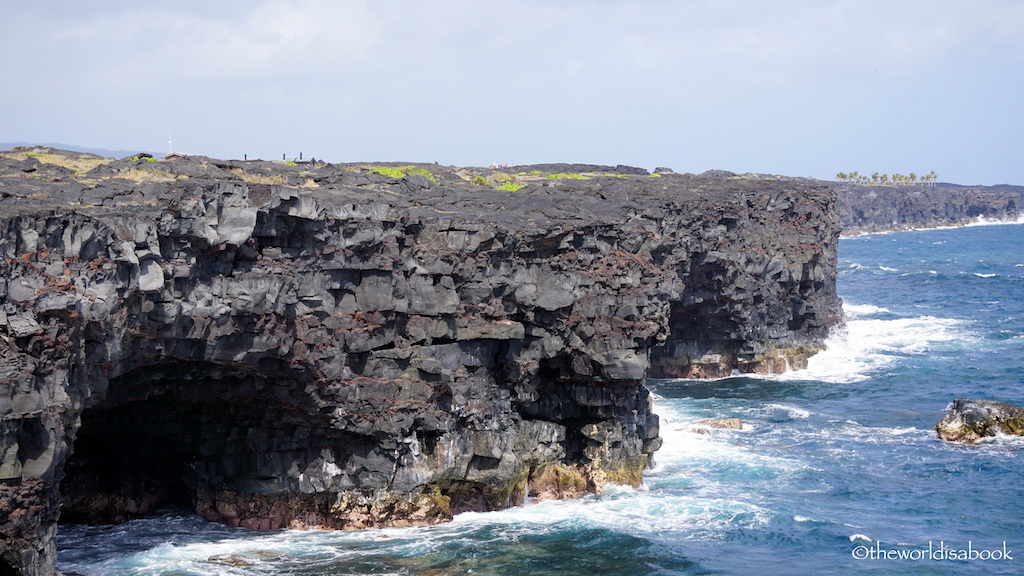
The main attraction here is the Holei Sea Arch. There’s a small viewing platform for visitors to see the arch along with some spectacular ocean views. The arch was formed only within the last 100 years through wave erosion.
The sea arch is about 90 ft (27.4 m) high and it was an unexpected gem in this land of volcanoes. Unfortunately, just as it was created by waves, that will also be the result of its downfall. So, if you’re visiting this park, go see the arch before it collapses with the forces of nature.
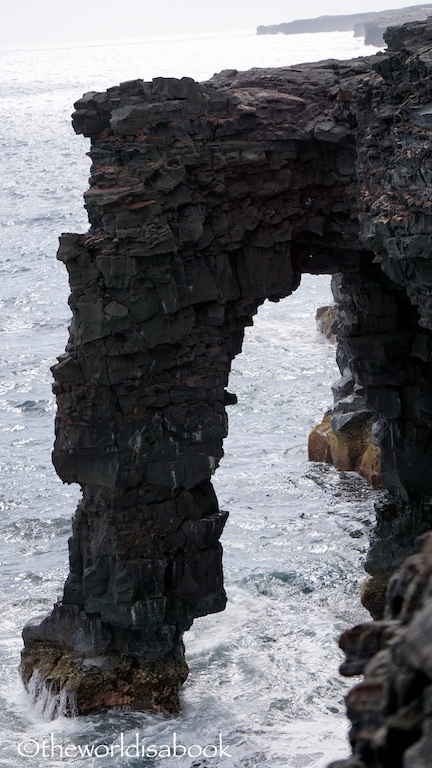
Here is a closer look at those interesting rocks on the arch. They almost looked like they were stacked individually.
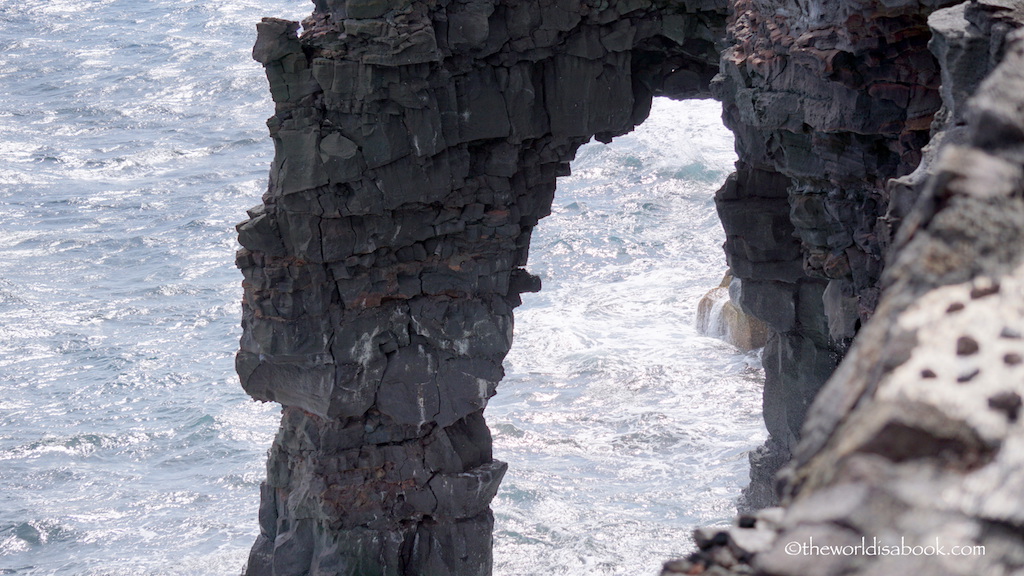
Part of the road is closed now since lava has flowed here since 1986 and covered most of the road. There is only an emergency area gravel road at this point.
It’s a great way to see how new land is being formed. Volcanoes National Park has grown by several hundred acres since lava has actively flown here in 1986.
Hike the Kilauea Iki Crater
We recently returned to the Big Island and Volcanoes National Park to specifically hike the Kilauea Iki Crater. It is so worth the 3.3 mile (5.3 km) loop from the Kilauea Iki overlook (across from the Thurston Lava Tube entrance. Note: Parking is very limited so come here very early.
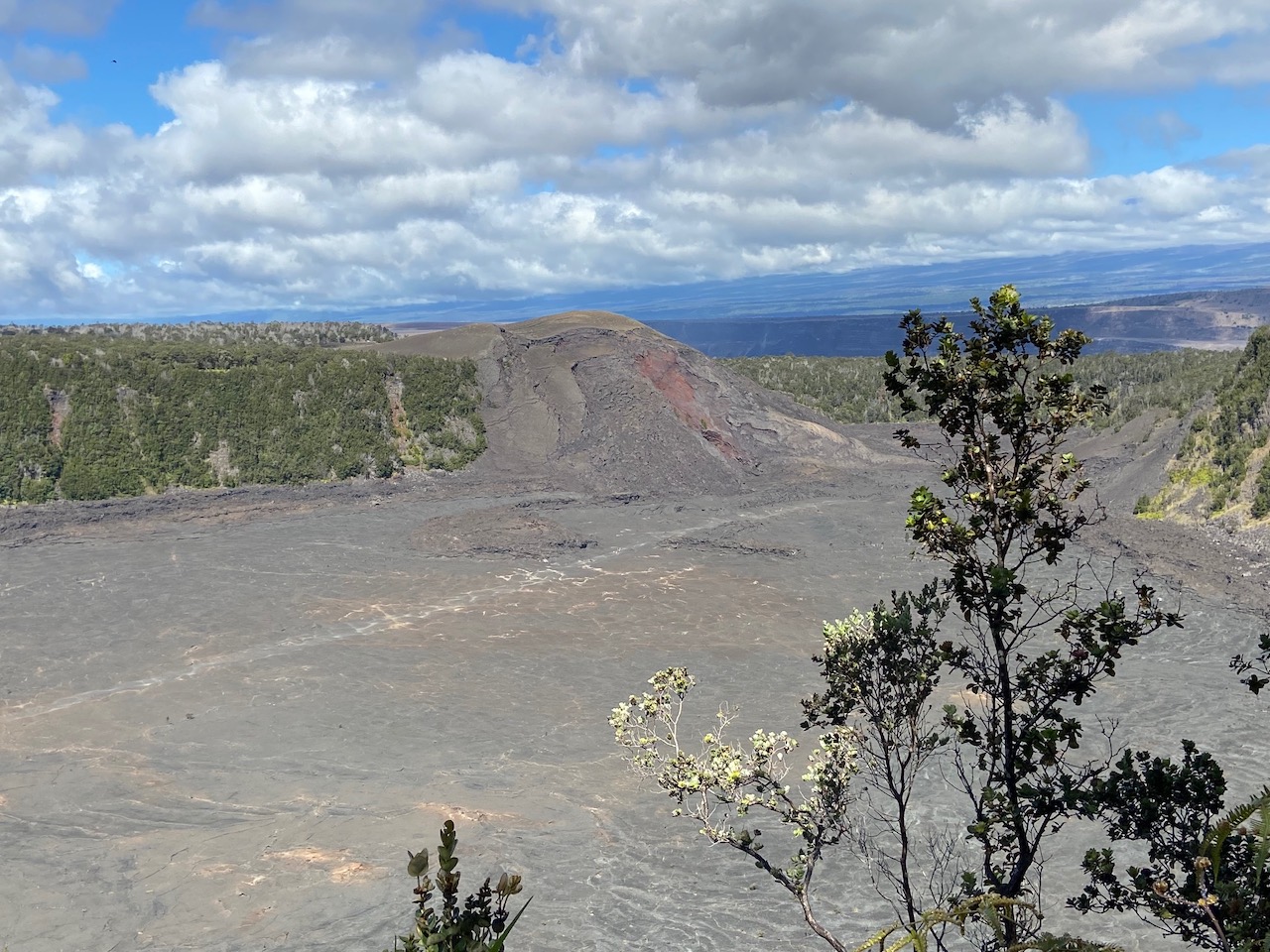
It was so wonderful to start the trail on a lush rainforest and then walk across a lava lake floor of the Kīlauea Iki crater. This is a descent & ascent of about 400 feet (122 m) on some steep and rocky terrain which can be very challenging on a hot summer day.
We loved hiking this trail and seeing the beautiful vegetation growing through the cracks and finding unique plants within the rainforest. We highly recommend doing this hike if you plan to spend an extra day at park.
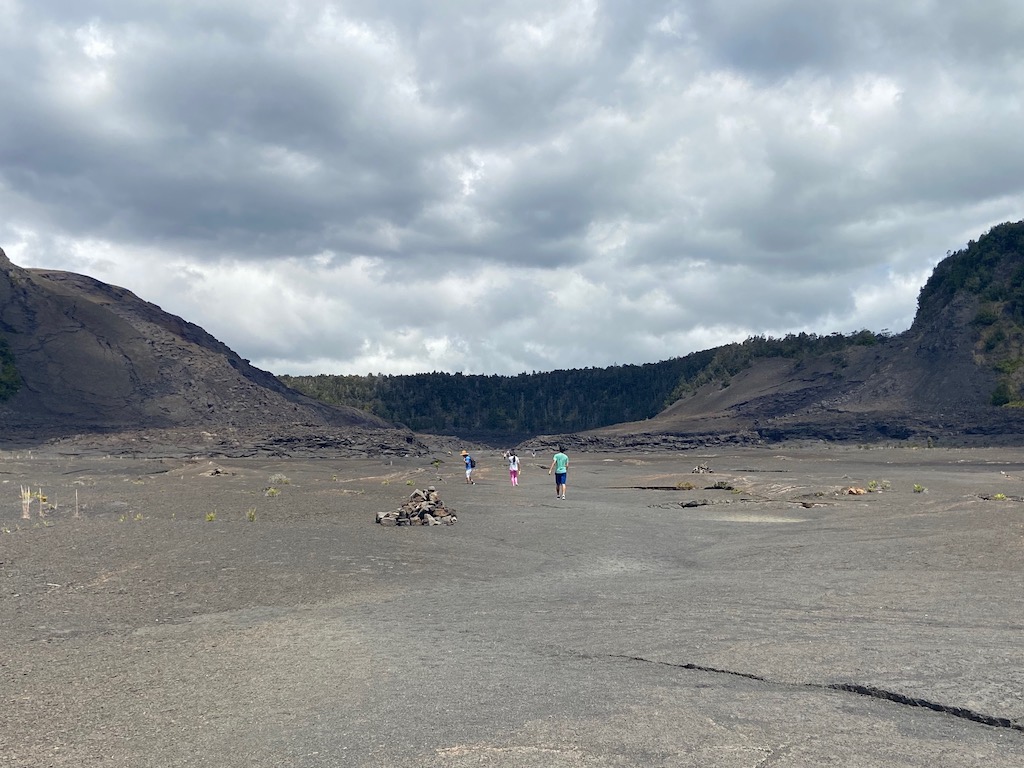
The park has over 150 miles of trails so there is so much of this area we have yet to explore despite multiple visits.
Do the Junior Ranger Program
The Junior Ranger program has been an invaluable educational tool for our family when visiting the national parks. Kids learn about the parks and the value of conservation through activities while earning badges, stickers or special prizes These are ideal for kids ages 7-12.
I admit that I liked doing them with my kids to learn more about the parks. So, while your kids are still young, get the booklets from the visitor centers. This park currently offers a coloring book, virtual scavenger hunt or designing your own arrowhead.
How to see the Lava Flow
Seeing the lava flow. If there is active volcanic activity, there are boat tours that leave from Hilo as well as various helicopter tours that leave from around the island.
The park ranger also told us that visitors can hike four miles one way on the gravel road plus an additional mile on lava field from the end of Chain of Craters Road. There is also another option to bike to an area. Visitors can go to Highway 130 towards the Hilo direction.
They told us to make a right on the fifth stop light. The end of Highway 130 south has several bike rental companies. Bikes ranged from $10-$20. Visitors can then ride 4.5 miles (7 km) one way to lava flow on the ground and into the ocean. Bring binoculars for this experience.
Where is the Hawaii Volcanoes National Park located?
The park is about two hours from the Kona area. It makes for a very long road trip with a lot of driving that crosses the whole island. Be prepared for a long day if you’re staying in Kona.
Hawaii Volcanoes National Park is located about 40 minutes from Hilo. We recommend staying in Hilo or use the lodging inside the park like Volcano House across from the Kīlauea Visitor Center.
This has 33 rooms plus a snack bar, dining room and gift shop. We loved the view of Halema’uma’u crater from its lounge and dining area. They had a reasonably priced menu. There are also cabins and campsites in the nearby Nāmakanipaio Campground.
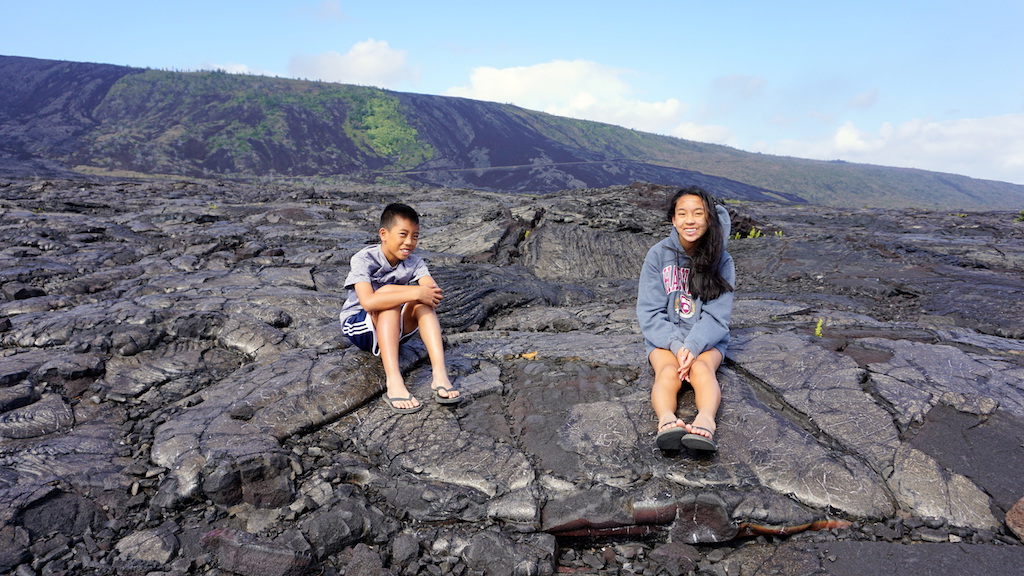
This is such an incredible and unique park that we highly recommend visiting no matter where you’re staying on the Big Island or how long your stay is. It is doable to do many activities on a day trip here.
There aren’t many places to witness an active volcano and its activity. This park does a great job of showing the volcano’s power but also offers a native ecosystem and ancient Hawaiian culture and history many visitors can appreciate.
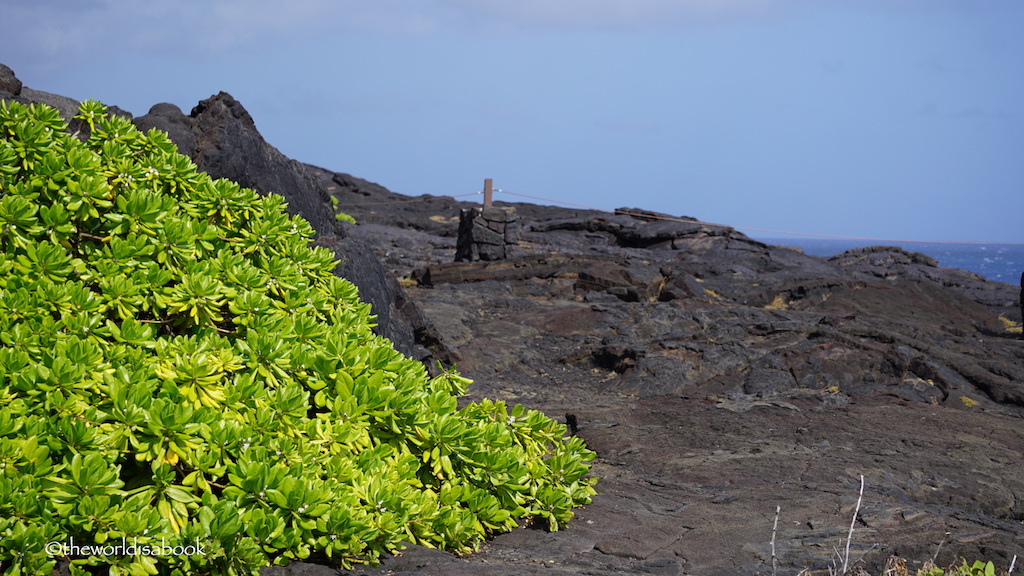
Tips for Visiting Hawaii Volcanoes National Park
- Park admission is $30 per vehicle for seven days. You can save money by buying the America the Beautiful Pass for $80 good for all the US national parks. You can also visit the other national park sites on the Big Island with this pass. The US National Park sets aside several days annually to enter the parks for free. Check the National Park Service site every year.
- The park is open 24 hours a day. Rangers have told us staying into the night allows for seeing the glowing lava flow in some areas and some remarkable star gazing.
- Stop at the Kīlauea visitor center to chat with the rangers and plan your itinerary.
- If you’re a an active or retired US Armed Forces, Reserve, National Guard or current and retired Department of Defense civilian employees, Kilauea Military Camp can be reserved. This was a great location within the park along the Crater Rim Road and has some cottages and apartments.
- Apply plenty of sunscreen and insect repellant especially when doing some of the hikes.
- Wear layers. There was a drastic change in temperature from the top where it was quite cool to hot by the ocean. We also experienced a slight drizzle and very windy areas.
- Wear sturdy walking shoes when walking on the lava fields. Some of the rocks were sharp.
- Gas up and stock up on food, snacks and water when driving the Chain of Craters Road. There are no services along this road. There are vault-type toilets at the Mauna Ulu parking area and at the end of the drive. There is also snack availability at the “end of the road” building.
- Here are some other tips for visiting National Parks with kids.
Have you visited Volcanoes National Park?
Pin it for later!
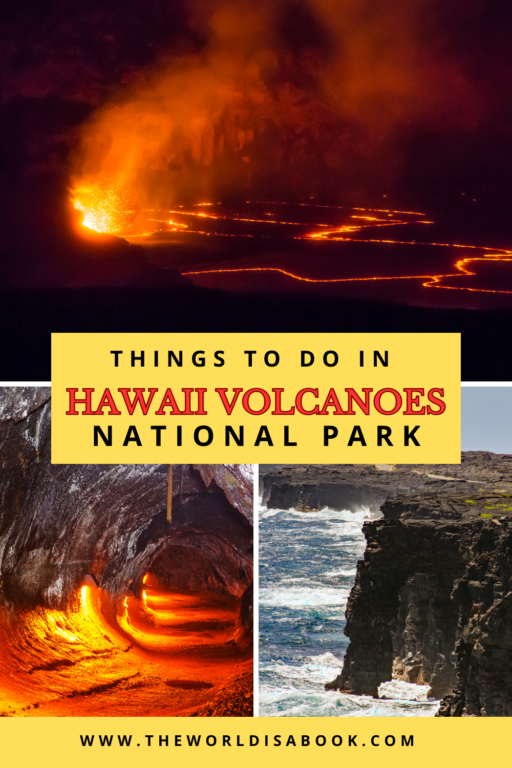
This has to be one of the craziest landscapes on Earth! I really want to visit this park one day. Hawaii’s Big Island is interesting to me because it is larger than Puerto Rico (I tend to compare islands sized with respect to Puerto Rico) but the interior is bare and kind of a no go area because of the volcanic activity. So, in there, the population lives in the coastal areas. #TPThursday
I hope you guys get to visit Hawaii soon, Ruth. It really is a crazy landscape. I’m like you… I compare island sizes to my island home of Guam.
Hawaii is on my daughter’s wishlist so I really enjoyed reading this and thanks for the comprehensive tips and the pin. Pinned to my Hawaii board! I won’t tell my daughter about the rotten egg smell! #WeekendTravelInspiration
I hope you daughter fulfills her wish soon! The rotten egg smell wasn’t so bad. :) Thanks for pinning!
The Big Island is the only major Hawaiian island I haven’t been to. But it’s definitely on my list – and I would love to see all the volcanic action and the national park. I saved a boat trip listing from years ago and every now and then I try to find some low fares and talk my husband into going. It’s just so far for us – and also would take many vacation days. But fingers crossed it will happen in the near future!
Fingers crossed for you too. Hawaii is quite different from the other islands. We didn’t get to do the boat trip so I’m saving a photo too for inspiration.
Just a stunning spot. We didn’t stay to see the lava glow in the dark (I was outvoted 4 to 1 :( because it was too cold for everyone) and I deeply regret not kicking up more of a stink about it. I want to go back to see the lava fall into the ocean, as it wasn’t doing that when we were there but is now….
We had to get back to Kona for our red eye flight so we didn’t stay later to see the lava glow either. I regret not visiting on another day. We’d love to do it next time for sure and doing a helicopter or boat tour.
Hawaii Volcanoes National Park is such a fascinating place, isn’t it? We’ve been there many times and every time we went there seem to be new things to discover. I’ll never forget the walk through the crater. It was amazing to see plants growing from the lava rock.
I have not seen active volcanos in person before so this is definitely at the top of my list for my next rip to Hawaii. Your pictures are amazing. Thanks for sharing on #TheWeeklyPostcard.
Volcanoes National Park looks so amazing – I know a few people who went recently and they’ve talked non-stop about how wonderful their visit was. It’s definitely on my bucket list! #TheWeeklyPostcard
Great information. It sounds like such a cool place. The the lava tubes look fascinating. Great pictures too!
This is one of my favorite destinations anywhere! We stayed at the military camp right inside the crater. Very cool! Thanks for linking in this week at #wkendtravelinspiration!
Hawaii is one of the two states we have yet to visit…so I am saving this post for the future! #weekendwanderlust
I’ve been there several times over the years and it’s amazing. Love Little Ita too and crossed the lava lake trail one day. Nature and the spirits are very strong on those volcanoes.
The Scenery and experience your post has sown here is amazing. The Holei Sea Arch seems so fragile, like it could fall down at any time.
We really enjoyed our visit to Volcanoes NP many years ago. Having visited Disney a lot, my then-10-year-old commented that seeing the caldera at night seemed like it could have just been Disney special effects with a glowing light and smoke machine. The rest of the museum and viewing area was pitch black, and there was a large group of people chanting and singing together. Very memorable! We hiked the unlit portion of the Thurston Lava Tube where my then-5-year-old believed us when we told her there was a Starbucks at the end. Best of all, the annual Cultural Festival was going on at the Military Camp, so we got to enjoy traditional games, crafts, food and performances.